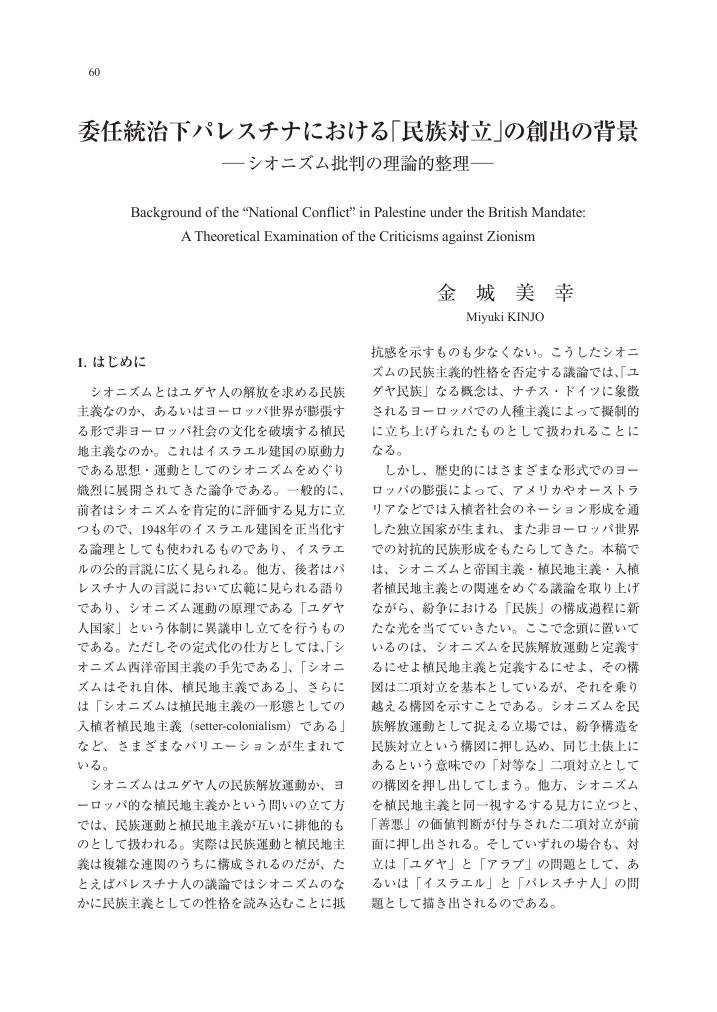3 0 0 0 OA 肝細胞癌による閉塞性黄疸に対する内視鏡的胆道ドレナージの有用性
- 著者
- 金子 由佳 金城 美幸 渡辺 秀樹
- 出版者
- 一般社団法人 日本肝臓学会
- 雑誌
- 肝臓 (ISSN:04514203)
- 巻号頁・発行日
- vol.64, no.11, pp.550-558, 2023-11-01 (Released:2023-11-10)
- 参考文献数
- 19
胆管浸潤や胆管圧排による閉塞性黄疸を伴う肝細胞癌に対する内視鏡的胆道ドレナージの有効性について検討した.2008年1月から2023年3月までに閉塞性黄疸を呈した肝細胞癌は20例だった.男性16例,女性4例で,平均年齢は75±8歳,門脈浸潤は,Vp0/Vp2/Vp3=13/3/4例,ステント挿入例は16例であった.閉塞性黄疸の改善の有無で全生存期間(OS)を比較すると,黄疸改善例では良好なOSを認めた(p<0.001).プラスチックステント7例,自己拡張型金属ステント9例で両者のOSに明らかな有意差を認めなかった(p=0.218).ドレナージ前後のT.Bil値で有意差を認めた(p=0.001).肝予備能の低下した進行期の肝細胞癌の閉塞性黄疸に対する内視鏡的胆道ドレナージは有用であり,患者の全身状態を考慮しながら検討すべきである.
- 著者
- 金城 美幸
- 出版者
- 日本ユダヤ学会
- 雑誌
- ユダヤ・イスラエル研究 (ISSN:09162984)
- 巻号頁・発行日
- vol.33, pp.89, 2019 (Released:2022-11-01)
- 著者
- 大科 枝里 小林 正典 金城 美幸 中川 美奈 大塚 和朗 赤星 径一 田邉 稔 松木 裕子 小林 大輔 岡本 隆一
- 出版者
- 一般財団法人 日本消化器病学会
- 雑誌
- 日本消化器病学会雑誌 (ISSN:04466586)
- 巻号頁・発行日
- vol.119, no.7, pp.683-691, 2022-07-10 (Released:2022-07-11)
- 参考文献数
- 24
52歳,女性.胆道閉鎖症にて生後120日で胆囊十二指腸吻合術が行われた.反復する胆管炎に対して内視鏡治療を行った際の胆汁細胞診でClass Vが検出された.マッピング生検で胆囊管肝管合流部に癌を確認し,肝外胆管切除術,胆管空腸吻合術を行った.胆管癌はBilIN-3までの粘膜内癌でR0切除であった.胆道閉鎖症に対する胆囊十二指腸吻合術はまれで,術後長期の胆管癌合併の報告はなく,文献的考察を加えて報告する.
2 0 0 0 OA 委任統治下パレスチナにおける「民族対立」の創出の背景
- 著者
- 金城 美幸
- 出版者
- 日本ユダヤ学会
- 雑誌
- ユダヤ・イスラエル研究 (ISSN:09162984)
- 巻号頁・発行日
- vol.32, pp.60, 2018 (Released:2021-05-09)
- 著者
- カナーアナ シャリーフ ゼイターウィー ニハード 金城 美幸
- 出版者
- 東京大学東洋文化研究所
- 雑誌
- 東洋文化研究所紀要 (ISSN:05638089)
- 巻号頁・発行日
- vol.171, pp.188-114, 2017-03
This paper presents a commentary and a Japanese translation of Deir Yassin: The Destroyed Palestinian Villages, No. 4 (1987. Kana'ana, Sharif, and Nihad Zeitawi. Birzeit: Center for Research and Documentation of Palestinian Society.). The original book is written in Modern Standard Arabic (its descriptive part) and in the village dialect (citations from villagers' speeches). It is one of the publications from a research project conducted from 1986 to 1998 at Birzeit University, located in the West Bank of the occupied Palestinian territories. This research project aimed to collect and record Palestinian refugees' oral narratives of their native villages that were destroyed in 1948 because of the establishment of the State of Israel. The book is composed of the following four chapters: (1) The popular history of the village; (2) The clans and families; (3) The village in the 1940s; and (4) The politics, the escape, and the exodus. This project preceded a new wave of historical accounts in Palestinian refugee communities of their original village, and more than 120 similar books have been published since then, recording their homeland based on the former villagers' narratives. It is noteworthy that these books based on oral history began to be written after the Palestinian diaspora leaders were defeated in Beirut (1982). Many Israeli and Palestinian researchers have argued over the question of why Palestinian Arabs became refugees in 1948. As Israel has ruled most of the area in the region, the historiographies in Israel have dominated the Palestinian historical narrative. Especially after the 1980s, when Israeli historians started to publish their research on the cause of the refugee problem based on the then newly declassified state archives, the "positivist" historiographies gained a great influence over the historical dispute as a whole. In this renewed debate, the Palestinian oral histor y was sidelined again and was regarded as a distor ted narrative. This translated text is dedicated to the village of Deir Yassin, which will always be linked with the massacre that took place in 1948. Although Deir Yassin is the village that has most often been refer red to in the historical dispute, refugees' memor y of the village reveals the rich layers of folklore that once existed there. The villagers' narratives show us how much the destruction of their homeland means to them, a point that has long been dismissed in the traditional historical dispute.
- 著者
- 金城 美幸
- 出版者
- 東京大学東洋文化研究所
- 雑誌
- 東洋文化研究所紀要 = The memoirs of Institute for Advanced Studies on Asia (ISSN:05638089)
- 巻号頁・発行日
- vol.171, pp.114-188, 2017-03
This paper presents a commentary and a Japanese translation of Deir Yassin: The Destroyed Palestinian Villages, No. 4 (1987. Kana’ana, Sharif, and Nihad Zeitawi. Birzeit: Center for Research and Documentation of Palestinian Society.). The original book is written in Modern Standard Arabic (its descriptive part) and in the village dialect (citations from villagers’ speeches). It is one of the publications from a research project conducted from 1986 to 1998 at Birzeit University, located in the West Bank of the occupied Palestinian territories. This research project aimed to collect and record Palestinian refugees’ oral narratives of their native villages that were destroyed in 1948 because of the establishment of the State of Israel. The book is composed of the following four chapters: (1) The popular history of the village; (2) The clans and families; (3) The village in the 1940s; and (4) The politics, the escape, and the exodus. This project preceded a new wave of historical accounts in Palestinian refugee communities of their original village, and more than 120 similar books have been published since then, recording their homeland based on the former villagers’ narratives. It is noteworthy that these books based on oral history began to be written after the Palestinian diaspora leaders were defeated in Beirut (1982). Many Israeli and Palestinian researchers have argued over the question of why Palestinian Arabs became refugees in 1948. As Israel has ruled most of the area in the region, the historiographies in Israel have dominated the Palestinian historical narrative. Especially after the 1980s, when Israeli historians started to publish their research on the cause of the refugee problem based on the then newly declassified state archives, the "positivist" historiographies gained a great influence over the historical dispute as a whole. In this renewed debate, the Palestinian oral histor y was sidelined again and was regarded as a distor ted narrative. This translated text is dedicated to the village of Deir Yassin, which will always be linked with the massacre that took place in 1948. Although Deir Yassin is the village that has most often been refer red to in the historical dispute, refugees’ memor y of the village reveals the rich layers of folklore that once existed there. The villagers’ narratives show us how much the destruction of their homeland means to them, a point that has long been dismissed in the traditional historical dispute.

